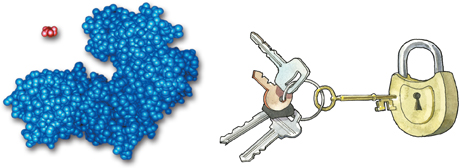The substrates bind to a site on the enzyme called the active site. The active site and the substrates have complementary shapes. The fit is so precise that the active site and substrates are often compared to a lock and key, as shown in Figure 2–23.
Regulation of Enzyme Activity Enzymes play essential roles in controlling chemical pathways, making materials that cells need, releasing energy, and transferring information. Because they are catalysts for reactions, enzymes can be affected by any variable that influences a chemical reaction.  Temperature, pH, and regulatory molecules can affect the activity of enzymes.
Temperature, pH, and regulatory molecules can affect the activity of enzymes.
Many enzymes are affected by changes in temperature. Not surprisingly, those enzymes produced by human cells generally work best at temperatures close to 37°C, the normal temperature of the human body. Enzymes work best at certain ionic conditions and pH values. For example, the stomach enzyme pepsin, which begins protein digestion, works best under acidic conditions. In addition, the activities of most enzymes are regulated by molecules that carry chemical signals within cells, switching enzymes “on” or “off” as needed.
MYSTERY CLUE 
The chemical reactions of living things, including those that require oxygen, occur more slowly at low temperatures. How would frigid antarctic waters affect the ice fish's need for oxygen?
VISUAL ANALOGY
UNLOCKING ENZYMES

FIGURE 2–23 This space-filling model shows how a substrate binds to an active site on an enzyme. The fit between an enzyme and its substrates is so specific it is often compared to a lock and key.
2.4 Assessment

-
Review What happens to chemical bonds during chemical reactions?
Apply Concepts Why is the melting of ice not a chemical reaction?
-
Review What is activation energy?
Compare and Contrast Describe the difference between a reaction that occurs spontaneously and one that does not.
-
Review What are enzymes?
Explain Explain how enzymes work, including the role of the enzyme-substrate complex.
Use Analogies A change in pH can change the shape of a protein. How might a change in pH affect the function of an enzyme such as carbonic anhydrase? (Hint: Think about the analogy of the lock and key.)
VISUAL THINKING
Make a model that demonstrates the fit between an enzyme and its substrate. Show your model to a friend or family member and explain how enzymes work using your model.

Table of Contents
- Formulas and Equations
- Applying Formulas and Equations
- Mean, Median, and Mode
- Estimation
- Using Measurements in Calculations
- Effects of Measurement Errors
- Accuracy
- Precision
- Comparing Accuracy and Precision
- Significant Figures
- Calculating With Significant Figures
- Scientific Notation
- Calculating With Scientific Notation
- Dimensional Analysis
- Applying Dimensional Analysis




